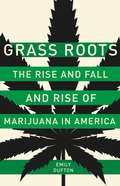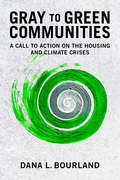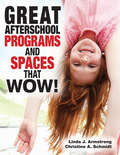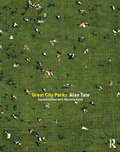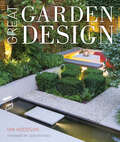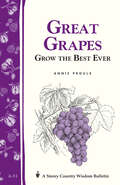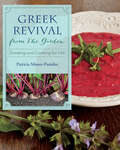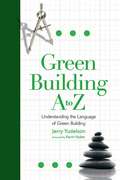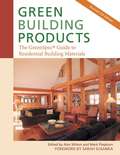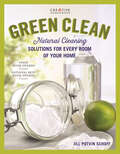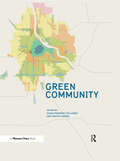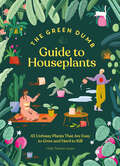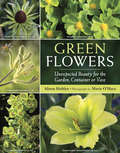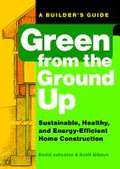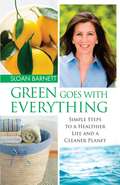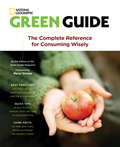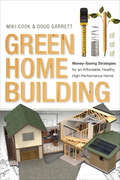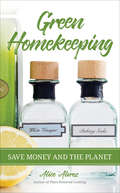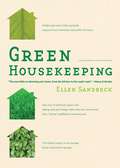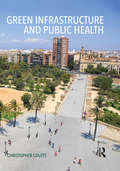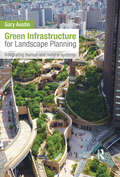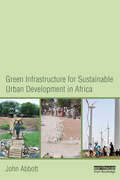- Table View
- List View
Grass Roots: The Rise and Fall and Rise of Marijuana in America
by Emily DuftonHow earnest hippies, frightened parents, suffering patients, and other ordinary Americans went to war over marijuanaIn the last five years, eight states have legalized recreational marijuana. To many, continued progress seems certain. But pot was on a similar trajectory forty years ago, only to encounter a fierce backlash. In Grass Roots, historian Emily Dufton tells the remarkable story of marijuana's crooked path from acceptance to demonization and back again, and of the thousands of grassroots activists who made changing marijuana laws their life's work.During the 1970s, pro-pot campaigners with roots in the counterculture secured the drug's decriminalization in a dozen states. Soon, though, concerned parents began to mobilize; finding a champion in Nancy Reagan, they transformed pot into a national scourge and helped to pave the way for an aggressive war on drugs. Chastened marijuana advocates retooled their message, promoting pot as a medical necessity and eventually declaring legalization a matter of racial justice. For the moment, these activists are succeeding--but marijuana's history suggests how swiftly another counterrevolution could unfold.
Gray to Green Communities: A Call to Action on the Housing and Climate Crises
by Dana BourlandIn Gray to Green Communities, green affordable housing expert Dana Bourland argues that we need to move away from a traditional gray housing model, to a green housing model, which considers the health and well-being of residents, their communities, and the planet.Bourland draws from her experience leading the Green Communities Program at Enterprise Community Partners, which resulted in the first standard for green affordable housing.The book opens with the potential of green affordable housing, followed by the problems that it is helping to solve, challenges in the approach that need to be overcome, and recommendations for the future of green affordable housing. Gray to Green Communities brings together stories from the people and projects of the Green Communities' program.Gray to Green Communities will empower and inspire anyone interested in the future of housing and our planet.
Great Afterschool Programs and Spaces That Wow!
by Linda J. Armstrong Christine A SchmidtDoes your afterschool program have the WOW factor?Create a high quality school-age program that is exciting, inviting, and reflects the interests, abilities, and needs of the children. Whether your program operates before or after school, on non-school days, during the summer, or overnight, you can create a dynamic environment where everyone will enjoy spending time.This book is filled with hundreds of ideas-from setting up a quiet reading nook to tackling clutter-reflecting the authors' years of experience and hundreds of visits to a variety of school-age programs. It takes you through all of the considerations that affect your program and then lays out a process to help you improve the three dimensions of a school-age environment.Temporal: Establish schedules, routines, rules, and learning opportunities to meet children's needsInterpersonal: Facilitate the relationships and social interactions of children, staff, families, and the greater communityPhysical: Create sensory-rich indoor and outdoor spacesLinda J. Armstrong and Christine A. Schmidt are experienced educational consultants who serve children and youth programs throughout the United States.
Great City Parks
by Alan TateGreat City Parks is a celebration of some of the finest achievements of landscape architecture in the public realm. It is a comparative study of thirty significant public parks in major cities across Western Europe and North America. Collectively, they give a clear picture of why parks have been created, how they have been designed, how they are managed, and what plans are being made for them at the beginning of the twenty-first century. Based on unique research including extensive site visits and interviews with the managing organisations, this book is illustrated throughout with clear plans and photographs– with this new edition featuring full colour throughout. Tate updates his seminal 2001 work with 10 additional parks, including: The High Line in NYC, Golden Gate Park in San Francisco and Westergasfabriek, Amsterdam. All the previous city parks have also been updated and revised to reflect current usage and management. This book reflects a belief that well planned, well designed and well managed parks and park systems will continue to make major contributions to the quality of life in an increasingly urbanized world.
Great Garden Design: Contemporary Inspiration For Outdoor Spaces
by Ian Hodgson“Showcases a wide variety of popular garden styles from rustic rural charm to minimalist urban chic . . . Packed with stunning photography.” —The Joy of Plants.co.ukThis book presents the best garden designs of the last ten years from more than fifty top garden designers. It offers design solutions for every situation, every area, all tastes and budgets, and any size of garden. It draws on the talents of celebrated designers such as Tom Stuart Smith, Luciano Giubbilei, Charlotte Rowe, Ian Kitson, John Brookes, Cleve West, Dan Pearson and Andy Sturgeon. It also showcases the work of lesser-known designers whose innovating designs deserve wider recognition.The process of garden design requires many thousands of small decisions in the pursuit of the most appealing solutions for outdoor spaces. But this book makes the complex process simpler by offering ample choices of contemporary design for you to explore what’s possible, what’s practical and what’s affordable.Comprising garden rooms, ornamental details, styles and planting ideas, this book will appeal to every garden owner, whether they manage a small or medium sized garden, a roof terrace, balcony or courtyard space. It offers cutting edge solutions for those seeking an entirely new look as well as key details that can make all the difference.
Great Grapes: Grow the Best Ever / Storey's Country Wisdom Bulletin A-53 (Storey Country Wisdom Bulletin Ser.)
by Annie ProulxGrapes are among the most desirable and best-known fruits, prized for their beauty, their succulence and varied flavors, their noble metamorphosis into wine, and their more utilitarian roles as sources of fresh juice and tasty jellies. <P><P>For most growers, the triumph of harvesting fragrant clusters of dusky-bloomed grapes in rose, blue-black, amber, purple, or light red bunches is its own reward--a test of gardening skill.In Great Grapes, you'll learn all you need to know to grow superb grapes, including how to: <br>-Choose the most suitable cultivars for your area <br>-Choose the right site <br>-Prepare the soil <br>-Build trellises <br>-Plant and train the vines <br>-Prune for maximum yield-Propagate new vines <br>-Control pests <br>-Harvest the grapes at the peak of ripeness
Greek Revival from the Garden: Growing and Cooking for Life (Young Palmetto Bks.)
by Patricia Moore-PastidesThe acclaimed cookbook author guides you from your garden to your dining table in this volume of Mediterranean recipes, organic gardening advice, and more.Patricia Moore-Pastides, author of Greek Revival: Cooking for Life, heads to the garden, offering guidance on how to cultivate a healthy diet from the ground up. An accomplished cook and public-health professional, Moore-Pastides presents all new recipes focused on bringing the bounty of the garden to the table in easy and accessible ways. The growing section provides all the information necessary for growing an exciting array of fruits and vegetables in containers, raised beds, or yard gardens. Topics include preparing the soil, composting to create organic fertilizer, watering, working with basic tools, and dealing with common pests and problems.Greek Revival from the Garden then invites the reader into the kitchen. This section assumes little prior cooking experience and includes kitchen safety, common equipment, and cooking methods. Moore-Pastides also shares fifty mouth-watering recipes featuring your harvest of homegrown vegetables, including garden gazpacho, curried butternut squash and apple soup, and nut crusted creamy almond fruit tart.
Green Building A to Z
by Jerry YudelsonGreen building is the fastest-growing trend to hit since the Internet, bringing with it an enormous range of new products, systems, and technologies. Green Building A to Z is an informative, technically accurate, and highly visual guide to green building, for both decision-makers and interested citizens. It begins with an introduction to the importance of green buildings and a brief history of the green building movement, outlines the benefits and costs of green buildings, and shows how you can influence the spread of green buildings. The book touches on key issues, such as enhancing water conservation, reducing energy use, and creating a conservation economy. The book examines all aspects of green buildings, including: Architecture 2030 Locally sourced materials Natural ventilation Solar energy Zero-net-energy buildings More than just a reference, this book emphasizes the importance of green buildings and green developments for a sustainable future. It will be an invaluable resource for businesspeople, homeowners, product manufacturers, developers, building industry professionals, and government officials.
Green Building Products
by Alex Wilson Mark PiepkornInterest in sustainable, green building practices is greater than ever. Whether concerned about allergies, energy costs, old-growth forests, or durability and long-term value, homeowners and builders are looking for ways to ensure that their homes are healthy, safe, beautiful, and efficient.In these pages are descriptions and manufacturer contact information for more than 1,400 environmentally preferable products and materials. All phases of residential construction, from sitework to flooring to renewable energy, are covered. Products are grouped by function, and each chapter begins with a discussion of key environmental considerations and what to look for in a green product. Over 40 percent revised, this updated edition includes over 120 new products. Categories of products include: Sitework and landscaping Outdoor structures Decking Foundations, footers, and slabs Structural systems and components Sheathing Exterior finish and trim Roofing Doors and windows Insulation Flooring and floor coverings Interior finish and trim Caulks and adhesives Paints and coatings Mechanical systems/HVAC Plumbing, electrical, and lighting Appliances Furniture and furnishings Renewable energy Distributors and retailers An index of products and manufacturers makes for easy navigation. There is no more comprehensive resource for both the engaged homeowner and those who design and build homes.Editor Alex Wilson is president of BuildingGreen, an authoritative source for information on environmentally responsible design and construction, which also publishes Environmental Building News.Co-editor Mark Piepkorn has extensive experience with natural and traditional building methods.
Green Clean: Natural Cleaning Solutions for Every Room of Your Home
by Jill Potvin SchoffA guide to environmentally safe cleaning techniques and products to keep you and your family safe from household toxins. This eco-friendly handbook explains how to eliminate toxic chemical household cleaning agents from your life and replace them with natural, homemade solutions. Inspired by the author's experience as the mother of an allergic child, Green Clean provides practical, comprehensive advice for every household cleaning need from kitchen, bathroom, and laundry to windows, floors, grills, decks, and cars. Jill Potvin Schoff shows how to green up your chores and reduce your family&’s exposure to hazardous chemicals. Using safe, effective and inexpensive ingredients and recipes, she offers simple cleaning methods and smart tips that will keep both you and the environment healthy.
Green Community
by Timothy Mennel Susan Piedmont-PalladinoThe health of our planet and ourselves depends on how we plan, design, and construct the world between our buildings. Our increasing dependence on fossil fuels over the last century has given us unprecedented individual mobility and comfort, but the consequences are clear. Climate change, sprawl, and reliance on foreign oil are just a few of the challenges we face in designing new-and adapting existing-communities to be greener. Based on the National Building Museum's Green Community exhibition, this book is a collection of thought-provoking essays that illuminate the connections among personal health, community health, and our planet's health. Green Community brings together diverse experts, each of whom has a unique approach to sustainable planning, design, politics, and construction.
Green Dumb Guide to Houseplants: 45 Unfussy Plants That Are Easy to Grow and Hard to Kill
by Holly Theisen-JonesFor those who want to take care of houseplants but can hardly take care of themselves, The Green Dumb Guide to Houseplants is the perfect handbook for even the most greenery-inept individual.We all love the idea of houseplants, and maybe you've stood by helplessly as a cactus went all slimy or you've endured the perpetual indoor autumn of an unhappy Ficus. Good news—all of the plants in this book have two things in common: They're easy to find and hard to kill.The benefits of plant ownership are legion. Studies indicate just being around plants creates a relaxing effect on people. And plants make great roommates—no Peace Lily will ever criticize you for quitting your workout video to go finish a box of Triscuits. Does your bedroom have a mattress on the floor and Christmas lights taped to the wall? Put a Money Tree in the corner. Instant upgrade! Are you a corporate lackey trapped under fluorescent lights and a drop-tile ceiling? A colorful Calathea or a chunky little Aloe could help restore your will to live. The Green Dumb Guide to Houseplants is full of useful advice, crucial dos and don'ts, and realistic inspiration for all budgets and attention spans—ensuring success to even the most risk-averse, commitment-phobic indoor gardeners.THE EASIEST POSSIBLE GUIDE TO LEARNING THE BASICS OF PLANT CARE: No skills needed, except knowing how to read this book.FORTY-FIVE HOUSEPLANT PROFILES: EACH ONE EASY TO FIND AND HARD TO KILL: Divided into difficulty sections ranging from "Practically Plastic," "Chill," "Fussy," or "Master Gardener" (only one of those!), this handy houseplant book ensures you choose the right plant for your level of commitment.IF ALL ELSE FAILS, A BONUS SECTION ON HOW TO CHOOSE PLASTIC PLANTS: Shade doesn't only come from plants! Take your absolutely true advice with a healthy dose of humor.Perfect for:Everyone who has ever tried and failed to grow houseplantsDIY decoratorsAnyone starting out in a new home or apartmentA great gift for grads, newlyweds, and hosts or hostesses (along with a plant, of course)
Green Enough: Eat Better, Live Cleaner, Be Happier--All Without Driving Your Family Crazy!
by Leah SegedieA real, no-holds-barred take on making smart, healthy choices for you and your family.In Green Enough, Mamavation blogger Leah Segedie uncovers the truth behind the food and household products that are misleadingly labeled "all-natural" and healthy but are actually filled with chemicals and toxins. From furniture to packaged food, Leah guides you through detoxifying your home, diet, and lifestyle, showing you how to make the best choices possible. She exposes the brands and products that contain toxic and hormone-disrupting ingredients and gives guidelines on choosing safer products and organic produce that are free from toxic and persistent pesticides. She instructs you on making the move to meat, dairy, and eggs that are free of antibiotics, GMOs, growth hormones, and dangerous pathogens. She explains at what phases of childhood children are the most vulnerable and need more protection. And she includes delicious and kid-approved recipes to help you detoxify your cooking routine. It’s not about being perfect or 100% clean—none of us are—it’s about being green enough.
Green Flowers: Unexpected Beauty for the Garden, Container or Vase
by Alison Hoblyn Marie O'HaraGreen in the garden is at once the most common color of foliage and the rarest color found in flowers. Whether you're a home gardener looking for a jolt of freshness or a floral designer seeking inspiration, this charming collection of unexpected plants provides a palette of flowering greens for year-round display. Combining Marie O'Hara's sumptuous photography and Alison Hoblyn's evocative text, Green Flowers explores the history, botany, care, and cultivation of green-flowered plants. The hand-picked selection includes trees, grasses, vines and climbers, annuals, perennials, bulbs, wildflowers, exotics, orchids, edible plants, and water garden plants. The appeal of the selection is broad: Jack-in-the-pulpit provides curiosity; fritillaries and columbines lend quiet beauty; and green roses, hellebores, and irises are an excellent foil to their more colorful companions. Eighty-four plants are included in all. Complete tips on growing and arranging the plants are given for each entry, as well as an account of the interesting myths, history, and lore.
Green From the Ground Up: Sustainable, Healthy, And Energy-Efficient Home Construction (Builder's Guide Ser.)
by David Johnston Scott GibsonMy passion for green building is based on experience. I know that building green results in better houses and that it improves the lives of the people who live in them, not to mention the health of our planet.
Green Goes with Everything
by Sloan BarnettImagine if your best friend gave you vital information that could protect you and your family, and save you money, and help the planet. Imagine if you were given clear, simple choices, small changes that could have a big impact on your life. And you could still wear leather shoes and deodorant. You'd listen, right? Well, think of Today show contributor Sloan Barnett as that friend. A mother of three, a dedicated consumer advocate, Sloan gives us a fast, simple, down-toearth primer on the ways our homes are making us sick, and what we can all do to transform them into the safe sanctuaries we want and need them to be. Sloan exposes the toxic truth behind the household products we use every day -- from laundry detergent to toothpaste to lipstick. She explains how these and other seemingly benign stuff can harm us and our children. She offers an array of alternatives, and inspires us to see that we're never helpless: Every day, we have the power to make better, smarter, safer choices. Packed with common sense and sass, product picks and practical tips, Green Goes With Everything is for everyone who wants to live a healthier life.
Green Guide: The Complete Reference for Consuming Wisely
by Editors of Green GuidePaper or plastic? Organic or conventional? In a world that is rapidly going "green," how does the average person make decisions that are smart for the family-and good for the planet? The Green Guide is here to help, with the concepts and choices for Earth-conscious living. Presented in concise, information-packed chapters, this up-to-the-minute resource touches on every aspect of our lives, from grocery shopping to housecleaning to work, travel, and investing-enabling consumers to make informed decisions and simple changes that impact the planet in big ways. Easy-to-follow information and hundreds of fascinating sidebars, fact boxes, and other key elements recommend how you can replace unhealthy and environmentally damaging practices and products with more wholesome, comfortable, and aesthetically pleasing alternatives. Neither scholarly nor scare-mongering in tone, the lively text has been written in partnership with a board of noted experts-offering readers the most authoritative, engaging, comprehensive, and in-depth reference of its kind.Created by two of the strongest brands in conservation and the environment, and drawn from more than ten years of reputable coverage in The Green Guide newsletter, on-line and in print, this comprehensive resource is destined to become a must-have for millions of families and the first name in household reference books in this up-and-coming category.
Green Guide: The Complete Reference for Consuming Wisely
by Meryl StreepPaper or plastic? Organic or conventional? The Green Guide is here to help, with the concepts and choices for Earth-conscious living. Presented in concise, information-packed chapters, this up-to-the-minute resource touches on every aspect of our lives, from grocery shopping to housecleaning to work, travel, and investing, enabling consumers to make informed decisions and simple changes that impact the planet in big ways. Easy-to-follow information and hundreds of fascinating sidebars, fact boxes, and other key elements recommend how you can replace unhealthy and environmentally damaging practices and products with more wholesome, comfortable, and aesthetically pleasing alternatives. Neither scholarly nor scare-mongering in tone, the lively text has been written in partnership with a board of noted experts, offering readers the most authoritative, engaging, comprehensive, and in-depth reference of its kind. Created by two of the strongest brands in conservation and the environment, and drawn from more than ten years of reputable coverage in The Green Guide newsletter, on-line and in print, this comprehensive resource is destined to become a must-have for millions of families and the first name in household reference books in this up-and-coming category
Green Home Building: Money-Saving Strategies for an Affordable, Healthy, High-Performance Home
by Doug Garrett Miki CookA comprehensive guide to building green on any budget.According to conventional wisdom, building a green home is an expensive endeavor. The standard approach treats green as an add-on, tacking "premium" products, finishes, and equipment onto a traditional home design. As a result, many green home projects end up over budget or fail to achieve their environmental and performance goals.Green Home Building explodes the myth that green homes have to cost more. Using proven methods based on applied building science, the authors show how to:Lower base construction costs to provide funding for high performance upgradesAchieve a net-zero energy home, including "zero-ing" water, waste, carbon, and associated costs within fifteen yearsLive affordably into the future, despite anticipated rising costs for fuel, water, materials, taxes, and health careThis comprehensive guide to building green on any budget defines the strategies that maximize the return on green investments. Written for anyone who has ever been swayed by the argument that the price tag limits how green a home can be, Green Home Building is a must-read for builders, contractors, architects, designers, and homeowners.Miki Cook is a green building and sustainability consultant who has dedicated her career to educating contractors and the public on the strategies, methods, and benefits of green homes.Doug Garrett has trained thousands of homebuilders, architects, and sub-contractors to build energy-efficient homes using applied building science to improve comfort, durability, and healthfulness while meeting or exceeding the energy code.
Green Homekeeping: Save Money and the Planet
by Alice Alvrez Alice AlvarezFifty ways to make your home a sustainable and eco-friendly environment.Every decision you make, large and small, has an impact on the environment. This concise guide shows how you can make your daily impact planet-positive. With sections progressing from simple tips to deeper commitments, you can start with baby steps and move on to advanced eco-warrior!Discover dozens of inspired ideas that show how to:*Reduce your waste*Eat organic*Keep toxins out of your home*Compost leftover food*Shop wisely, and much more
Green House: Eco-Friendly Disposal and Recycling at Home
by Norm CramptonConsumers may already recycle newspapers and aluminum cans. But what about the containers that have both plastic and cardboard components? Should we really toss water bottle caps? Scratched CDs? Computers? Cell Phones? Green House: Eco-Friendly Disposal and Recycling at Home is an A to Z guide to disposing and recycling all varieties of common household trash, from broken appliances to spent smoke detectors to pet waste. Crampton provides informative, comprehensive and practical information for adopting greener and more earth friendly habits of disposal by promoting recycling and living a little lighter.
Green Housekeeping
by Ellen SandbeckWant a low-maintenance bathroom that takes 30 seconds a day to clean? Need whiter whites that get whiter for free? Learn to live in a clean, healthy, more economical -- and Earth-friendly -- way with Ellen Sandbeck's Green Housekeeping, the must-have book for the twenty-first-century home. You will learn to maintain every part of your home -- from living room to septic tank, kitchen floor to bathroom sink -- using safe, simple cleansers and quick, preventative measures that will save you time and money, save your health, and save the planet.
Green Infrastructure and Public Health
by Christopher CouttsThere is a growing body of knowledge revealing a sweeping array of connections between public health and green infrastructure – but not until now have the links between them been brought together in one comprehensive book. Green Infrastructure and Public Health provides an overview of current research and theories of the ecological relationships and mechanisms by which the environment influences human health and health behaviour. Covering a broad spectrum of contemporary understanding, Coutts outlines: public health models that explicitly promote the importance of the environment to health ways in which the quality of the landscape is tied to health challenges of maintaining viable landscapes amidst a rapidly changing global environment This book presents the case for fundamental human dependence on the natural environment and creates a bridge between contemporary science on the structure and form of a healthy landscape and the myriad ways that a healthy landscape supports healthy human beings. It presents ideal reading for students and practitioners of landscape architecture, urban design, planning, and health studies.
Green Infrastructure for Landscape Planning: Integrating Human and Natural Systems
by Gary AustinGreen infrastructure integrates human and natural systems through a network of corridors and spaces in mixed-use and urban settings. Austin takes a broad look at green infrastructure concepts, research and case studies to provide the student and professional with processes, criteria and data to support planning, design and implementation. Key topics of the book include: The benefits of green infrastructure as a conservation and planning tool Requirements of ecosystem health Green infrastructure ecosystem services that contribute to human physical and psychological health Planning processes leading to robust green infrastructure networks Design of green infrastructure elements for multiple uses. The concept of ecosystem services is extensively developed in this book, including biological treatment of stormwater and wastewater, opportunities for recreation, urban agriculture and emersion in a naturalistic setting. It defines planning and design processes as well as the political and economic facets of envisioning, funding and implementing green infrastructure networks. The book differs from others on the market by presenting the technical issues, requirements and performance of green infrastructure elements, along with the more traditional recreation and wildlife needs associated with greenway planning, providing information derived from environmental engineering to guide planners and landscape architects.
Green Infrastructure for Sustainable Urban Development in Africa
by John AbbottThis book shows for the first time how green infrastructure can work in an African urban context. On one level it provides a major rethinking of the role of infrastructure in urban society since the creation of networked infrastructure in the early twentieth century. On another, it explores the changing paradigms of urban development through the fundamental question of how decisions are made. With a focus on Africa's fast-growing secondary towns, where 70 per cent of the urban population live, the book explains how urban infrastructure provides the key to the relationship between economic development and social equity, through the mediation of natural resources. Adopting this view enables investment to be channelled more effectively to provide the engine for economic growth, while providing equitable services for all residents. At the same time, the mediation of resource flows integrates the metabolism of the city into the wider ecosystem. This vision leads to a new way of thinking about infrastructure, giving clear definition to the concept of green infrastructure. On the basis of research gathered throughout an extensive career, John Abbott draws in particular from his experience in Ethiopia to demonstrate the ways in which infrastructure needs to respond to the economies, societies and natural environments of twenty-first century urban Africa.
